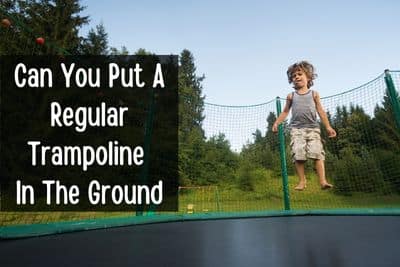In-ground trampoline is the new talk of the town. It is used mainly for recreational purposes, but it will also add aesthetics to your yard. I bet the idea of ‘Can you put a regular trampoline in the ground’ must have popped at least once in your mind.
Simply, the answer is yes, you can sink your normal trampoline in the earth, but you wouldn’t want to do it as there are better alternatives (in-ground trampolines) available, and considering other facts. However, if you want, it’s possible to do it.
Dive into the next section to the exact answer. In the last section of this article, I’ll give you some tips to install the regular trampoline in the ground.
Can You Put a Normal Trampoline in the Ground?

Putting the regular above-ground trampoline as an in-ground trampoline sounds pretty easy and reasonable. And why not? After all, it saves you the money on a new sunken model! Just get rid of the metal legs, dig holes in the ground and insert the trampoline.
But you might be less aware of the fact that by doing so, you seem to dig your own problems in a way. Adjusting the traditional trampoline to an in-ground one requires a lot of legwork and might even be dangerous for the kids, especially in the long run.
Regular trampolines won’t last longer as like the in-ground trampolines, especially when sinking on the earth. And in-ground trampolines also provide good aestheticscs that the normal trampolines don’t do.
So, what Is the best trampoline to put in the ground? Although above-ground trampolines are a more budget-friendly choice than the in-ground models, still due to the above-mentioned difficulties, it’s recommended to avoid burying the regular trampoline in the ground.
So, instead of putting a usual trampoline in the earth, sink the specially designed, durable, and aesthetically appealing in-ground trampolines in the ground for getting the best outcomes.
Read Also: Regular vs sunken trampoline
How to Put a Normal Trampoline on the Ground?
If you plan to sink a regular trampoline in the earth, you have to follow some steps below.
Step 1: Hole Preparation
Using an excavator dig a suitable hole maintaining the proper diameter and depth in the ground. The hole diameter should be quite smaller than the trampoline size. For kids’ trampoline, 3 feet deep hole. On the other hand, you should dig more than a 5 ft deep hole for the adult trampoline.
Step 2: Retaining Wall
Create a good retaining wall surrounding the trampoline hole so the soil is secured in place.
Step 3: Install the Trampoline
Afterward install the trampoline frame, springs, mat, pad, and enclosure net. Make sure, you detach the legs of the trampoline before installing the trampoline in the hole. And finally, install the trampoline there.
See Also: How to install in-ground trampoline?
Why Not to Sink a Regular Trampoline in the Ground?
Here I’ll cover different problems that you may experience with putting a regular trampoline in the earth. If you are wondering, is it okay to put a normal trampoline into the ground, the following section will help you understand the fact.
1. Digging All the Way Down
To allow the regular trampoline to sit on the ground, you need to do a lot of ground preparation and digging. This is because above-ground trampolines have very long metal legs, and to accommodate the legs, a lot of legwork needs to be done.
The hole depth is the deciding factor if the trampoline will be safe or not. The depth substantially needs to be installed at the ground level because if not, the trampoline surface will collide with the subsoil once after each jump.
Usually, the depth needs to be 3 feet for younger kids, and for the bigger kids, the depth needs to be 5 feet. If the height of the hole is less than 3 to 5 feet, chances are high you will encounter a severe knee injury.
Digging up to 3 to 5 feet tall by yourself is definitely not a joke. So, it is advisable to call a professional contractor to do the work. That’s not just it: over time, the soil expands after digging, eventually making your work even more arduous.
To save yourself from the mess, switch to an in-ground trampoline instead. The in-ground trampolines are designed so that there is less digging. It reduces up to 40% of the digging than the normal trampolines.
Read Also: Why sunken trampolines are safe?
2. Retaining Structural Integrity
Once you start to dig up the soil, it loses its stability. It is absolutely indispensable to ensure that the height of the trampoline is equal to the depth of the hole to maintain rigidity.
To embed the trampoline into the ground, you need to place small retaining walls surrounding the trampoline to provide firm support to the framework.
A proper installation is also essential to maintain the sturdiness of the trampoline- good leveling and sealing! The unlevel structure can make the trampoline wobbly. Not sealing the gaps in the holes will cause dirt to accumulate there. Eventually, the dirt will stack up to make gaps even wider.
In both scenarios, the loss will be yours. Over time, the trampoline will become unstable and might cause your kids to trip and fall.
Read Also: Can I put a trampoline on concrete?
3. Less Bounce, More Sound
Who doesn’t love a little bounce? Well, everyone does! That is why trampolines are widely loved by everyone, where you can jump as high as you want. What if you see that the bounce is less? Disappointing, right? By setting your regular trampoline into the ground, you might experience this disappointment.
In order to maintain a nice bounce off the trampoline, proper airflow is needed. But in such a case, where you are turning the normal trampoline into the in-ground one, adequate airflow is hindered. This happens when air is trapped beneath the bounce pad.
Since the air is trapped between the bounce pad and the soil surface, it will cause the bounce pad to become more rigid and inflexible, thereby causing resistance when you jump. Also, every time you jump, you will hear a screeching noise as the trapped air tries to escape.
Read Also: Sunken trampoline problems
4. Additional Costs
Yes, buying in-ground trampolines will definitely break your wallet. Still, you’re going to thank me later when you find out that installing above ground trampoline into the earth costs more than actually buying a new one. Let us break it down for you.
First, digging holes in the ground or soil is a highly labor-intensive and time-consuming process. As previously stated, a professional contractor is needed for this strenuous work and they charge a lot.
Second, a regular shovel is not very convenient for digging purposes. A mechanical digger is a must! The third is the need for additional retaining walls to ensure structural integrity is not compromised. All these costs will add up and exceed your budget!
Instead of going through all the troubles, grab your hands on the in-ground trampoline, and don’t let the fun go away!
Read Also: In-ground trampoline cost
5. Trampoline Gets Rusty Soon
The traditional above-ground trampolines are designed sturdily to withstand harsh weather like rain and sun. But they aren’t made to fight against moisture and soil. Thus, they might corrode and rust soon if you implant them in the ground.
The metal parts of trampolines like springs, frame, and legs will get rusty soon, thus weakening the structure and reducing their lifespan significantly. That being said, avoid installing the normal trampolines to sink in the ground.
Read Also: Trampoline assembly mistakes and solutions
Takeaways
Although the idea of using a regular trampoline and modifying it into an in-ground one indeed seems rational, the follow-up of this isn’t much more rewarding. It might be a bit expensive, but purchasing an in-ground trampoline will be a good investment, especially in the long run.
So, installing the sunken trampoline models rather than putting a traditional trampoline in the ground is better option. Still, if you can’t afford an in-ground model, you can bury your normal trampoline in the earth, but this is not recommended.
Hopefully, you got your answer on “can you put a normal trampoline in the ground”. Now, the decision is up to you, but in-ground trampoline will be the best for your garden.
Your kids can jump their hearts out in the in-ground model, that too, without hurting themselves. Keeping your kids happy and healthy is something you would definitely want. Stop panicking and happy jumping!

Robert is a trampoline and rebounder trainer with a passion for blogging. He discovered his love for trampolining at a young age, when his father gifted him his first trampoline at the age of 9. Over the years, Robert has honed his skills and knowledge in the field, and now uses his expertise to train others.
Besides, helping fitness enthusiasts in the gym, Robert is very eager to share his knowledge and experience regarding trampolines and rebounder exercises with the readers of picktrampoline.com. He will share all you need to know about trampolines and rebounders in this blog. Get his tips on trampoline and rebounder!
